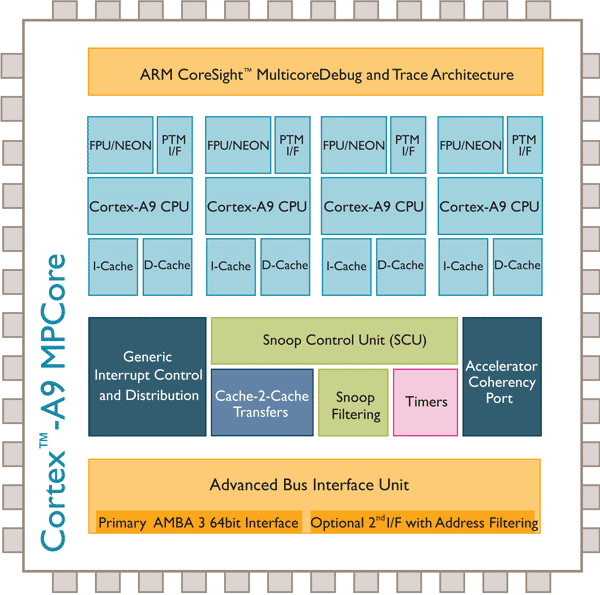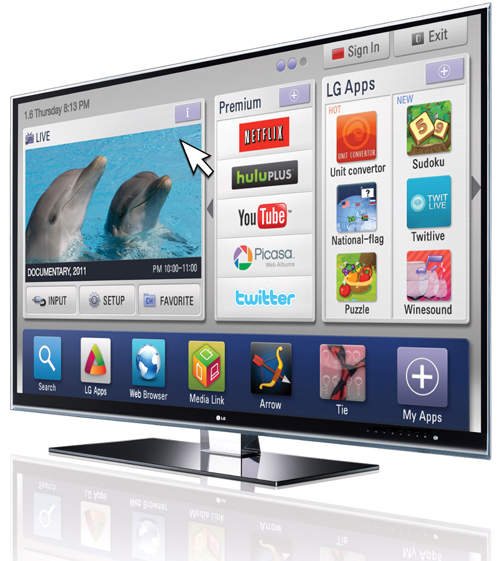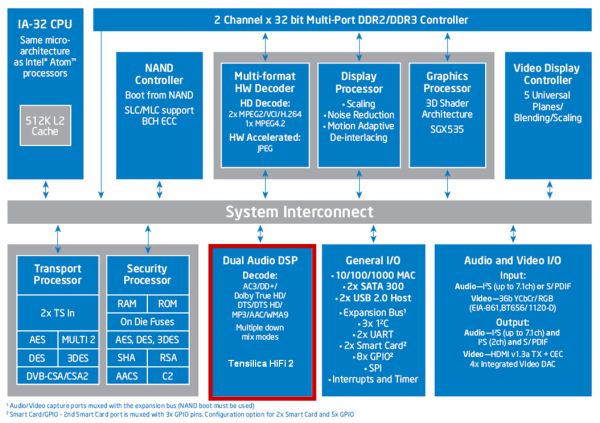LG's G6 Series: A New Kind of Google TV Partnership
by Jason Inofuentes on February 6, 2012 10:43 PM ESTLG L9
Ken was very excited to show us the G6 Series, a Smart TV line that combines their own UI and apps with Google TV 2.0. He excitedly cornered the product team members that were demonstrating the interface and stood by as I was walked through the features of the new set. When I was done he pulled me close and said excitedly, “That’s our chip inside, that’s the L9.”
Late last April, chip designer ARM put out a press release announcing that LG had licensed some of their IP for use in SoCs. If you check the ARM news site, you’ll see several such releases over the years with lots of different partners. The LG move seemed strategically sound; skipping the middleman and having the SoC specifications you want built by a fabricator could yield cost savings and tighter control. Nothing more was heard about the initiative until CES, when LG revealed it would be powering many members of their Smart TV line.

Looking back at that press release could reveal some clues as to what’s included in the LG L9. It describes the licensing agreement as comprehensive and while it specifies access to the Cortex-A9, Cortex-A15 and Mali-T604 designs, it does not do so in a way that would not presuppose access to other designs. Indeed, the release describes the license as covering the Mali family of GPUs. LG expects devices with the L9 to ship during the first half of 2012. Having been described as a dual-core design with a quad-core GPU would make the L9 most likely an ARM Cortex-A9 with a Mali-400 GPU. Such a combination is rather familiar, but also rather competitive, particular with regards to the GPU. From our prior coverage of SoC’s found in media streamers we know that these are generally more lightweight and focused on decoding and displaying video data. Traditionally streaming devices and smart TVs relied on lightweight UIs and functionality limited to just a handful of functions beyond media playback. Even the Roku 2, with its smooth UI and gaming abilities uses a relatively meager SoC compared to the LG L9.
At the time that the original Google TV hardware was released, the use of Intel’s CE4100 seemed a strange platform choice. Intel is fond of selling their products at high margins, a tendency that the consumer and enterprise PC markets support. Generally, SoC markets are CE markets, and only at the high-end do they tolerate high margins. The CE4100’s power profile also made it an unexpected choices. ARM based decoder ICs meant for the Blu-ray market have even started migrating to powerful Cortex-A9 class processors, so it was just a matter of time before Google TV moved on to an ARM based platform such as the ARMADA 1500 and the Mediatek Blu-ray SoCs, and now, the LG L9. Granted that, when the Logitech Revue hit the market, the notion of playing back HD video from a smartphone seemed a futuristic concept. But since then, powerful low power GPUs have provided the differentiation within the mobile space. Many of today’s mobile platforms provide excellent media playback, while also powering complicated UI elements at high resolutions. So it makes sense that the devices that power our TVs should be at least as powerful as our phones.
LG Smart TV with Google TV
LG has set its sales goals impressively high for their Smart TV platform. By their estimates, 60% of their TV sales should be Smart TVs. Achieving this goal will mean targeting a mainstream price point, though we’re not likely to see Smart TV sets below the 40” class. Most Smart TV UI’s are based around Java and HTML5, and developers have typically been required to work within a particular manufacturers SDK in order to get an app released on their platform. Recently, LG joined Philips and Sharp in an initiative to develop a joint SDK based on HTML5, CE-HTML and HbbTV. Ideally, after a successful joint SDK is released, app availability across the three platforms would reach parity with a unified storefront. This sort of partnership was always going to be a necessity before developers would seriously consider smart TV’s a platform to focus on. Other manufacturers remain resolute in keeping their platforms and SDK closed off. Companies don’t like sharing the spotlight, so collaborating on something that they could otherwise brand and promote all to themselves is anathema to some. Everyone wants to be the next Kleenex.

LG’s Smart TV offering is attractive, and straightforward. The home screen features three columns, with the left most featuring a panel displaying the currently playing content. Spread across the rest of the home screen icons for installed apps and services. The center column is reserved for premium apps such as Netflix and Hulu+. The right column will include other installed apps, including games. Across the bottom is a dock with several core apps with room for user selected apps. Controlling the UI is done through something similar to an air mouse solution. It’s referred to as motion controls, but it retains the point and click paradigm familiar to all; the intuitiveness of the solution depends on the accuracy with which the remote’s position reflects the cursor’s position.
When I first heard that LG would not simply be producing a Google TV but instead be marrying their own Smart TV solution with Google TV, I was trepidatious. Google TV’s first iteration involved their own UI layered atop the output of your set-top box, and often the result was having two UIs colliding onscreen, obstructing their own utility and the content being viewed. Worse than this, I worried that the LG Smart TV UI and Google TV would be walled off from each other. That if a user wanted to play an LG optimized version of Angry Birds they would have to exit their Google TV session and effectively reboot into LG’s garden. So, when I caught sight of the television itself I was quite surprised.











5 Comments
View All Comments
aryonoco - Tuesday, February 7, 2012 - link
"Going forward from Android 4.0, device manufacturer’s would be required to build their skins within the Theme framework Google provides, and that at all times, access to the default Holo theme would be retained. While this would still allow for OEM and carrier defined widgets and software preloads, the user would have access to the default core UI."No no no, this is wrong. This is not what's happening.
The Holo theme has to be present on the device, umodified, so that applications that want to use it can leverage it. The user has absolutely no say in what theme the app will use. OEMs can define their own theme, and Holo has to be present as well. Then, an app developer can either target the device native theme (i.e., the carrier theme) or the Holo theme, or define their own theme if they wish. There is nothing that says that a user has control over this.
"And all this is muddled when you see that some devices that blatantly break with the speculative standards Google sets for products are granted access to the Market."
Can you name one of these products which allegedly break the CTS and legally carry Market and other proprietary Google Apps? Cause I don't know of any, as as far as the ODMs that I've talked to are concerned, there is nothing "speculative" about the CTS. It's out there in the open for anyone to read:
http://source.android.com/compatibility/cts-intro....
Anandtech has for the past two years or so, had the best coverage of the mobile industry and Android in particular, bar none. I would hate for misinformation to be spread around via this credible source, without any credible evidence.
JasonInofuentes - Tuesday, February 7, 2012 - link
I appreciate the clarifications. After looking into it and talking to Brian, you're right, I got the Holo theme details wrong, and will update as suited. As far as the Market access rules though, this is a situation that has improved significantly of late, but is not so cut and dry as you think.The CTS ensures that a device meets a certain technical compatibility with Android and with Android apps, however it is not the only hurdle that must be met to obtain Market access. From the CTS FAQ:
"If my device is compatible, does it automatically have access to Android Market and branding?
Android Market is a service operated by Google. Achieving compatibility is a prerequisite for obtaining access to the Android Market software and branding. Device manufacturers should contact Google to obtain access to Android Market."
The Android Market is the value add by which Google leverages power over device manufacturers. When a company approaches Google with a CTS compliant device and seeks access to the Android Market, they negotiate an agreement and based on their compliance with the agreement they do or do not receive access. These agreements are private and covered by NDAs and rarely see the light of day. The last time one did was during the proceedings of a lawsuit brought by Skyhook, against Google.
The Verge (nee This Is My Next) covered this matter when it broke. (http://www.theverge.com/2011/05/12/google-android-... In that instance the devices in question had Market access revoked late in the product development cycle because of a dispute over which location service would be used. Ultimately, Samsung complied with Google's requests, and it seems likely that as a result of this exposure the CTS and ACD were made public (note that the CDD, previously the ACD, is on just its second revision as of last month). Making these things public removes the threat implicit of having to comply by a hidden document (and the license agreements exposed in the lawsuit make it clear that previously the CTS and ACD could be changed up until the moment of product release). But just because the CTS and ACD are public doesn't mean that Google must grant access to all products that meet CTS and ACD.
As far as examples of device that seemed to breach the assumed contents of the previously unpublished ACD? The OG Galaxy Tab is a good example. Prior to Samsung's Tab, several smaller manufacturer's (Viewsonic and Craig come to mind) had produced Android based tablets. None of them was granted Market access and the operating theory was that a cellular data modem and some form of telephony were a requirement for access; this was a safe assumption since Android was designed for phones, and up until the iPad, tablets seemed a niche market. But when the Galaxy Tab was announced it was noted as featuring the Android Market.
Even turning to Lenovo's announcement can show the lack of clarity. Lenovo's K91 one-ups Google itself by bringing ICS to TVs well ahead of Google's expectations, and is touted as having Market access. It's also acknowledged to be a Chinese market-only device. One problem: The Android Market isn't yet available in China, and possibly never will be. Ignoring the question of whether Market will ever reach China, does this mean that if Samsung chose to produce an ICS-based Smart TV that they would be granted Market access? It would be against Google's best interests to empower a manufacturer to fork Android-based TV's into Google TV's and Other.
Again, with a published CTS and the ACD/CDD this process is much clearer, but it's still ultimately a business negotiation the details of which are not known to the public, and this can lead to confusion.
aryonoco - Wednesday, February 8, 2012 - link
Thank you for your reply and clarification.You bring up good points about the CTS and Market certification. The original Galxy Tab was indeed an anomaly, and the recent Lenovo Android TV announcements had me puzzled as well.
I do however think that for the most part, this ambiguity is a reflection of fine balance that the CTS has to struck, in order to preserve compatibility and avoid fragmentation, while at the same time allowing Android to innovate and continue exploring new territories (like tablets, and now TVs). In order to perform such a function, the CTS has to be updatable by its nature to reflect the current versatility and maturity of the platform.
I think many of these ambiguities in Market certification and Google' reluctance to see Android deployed in areas it had not been designed to are a result of Android's earlier lack of suitability to scale in these areas. With ICS, a single platform can indeed scale from a 3" smartphone to a 70" TV and everything in between, while preserving app compatibility and layout. The newfound openness in the CTS probably also reflects that Google feels confident in the maturity of the platform, and that it can withstand challenges of being deployed in widely different environments.
Having said that, I wholeheartedly agree with you that the situation is less than completely transparent and less than ideal. It would be to everyone's advantages if the rules were out in the open, and merely complying with the CTS would guarantee Market certification. Unlike you, I don't think Google would actually lose anything if a manufacturer ran a fully-compliant ICS in their TV with access to Market, as opposed to the official Google TV. They both equally serve Google's intended purposes well.
8steve8 - Tuesday, February 7, 2012 - link
companies are so silly, trying to differentiate for the sake of differentiation...use google's 'skin', and the industry will have a familiar, clean, reliable, fast interface...
all these efforts at differentiation in android is only hurting the entire android movement.. LG/samsung etc suck at ui design... even if they were good, its an unnecessary tangent.
They all think consumers care/value their additions/customizations, which is blatantly false and maybe egotistical.
KalleSverige - Thursday, May 3, 2012 - link
Man, you are so wrong. Companies and Android phones need differentiation - even much more than today! Otherwise we'll have a boring ecosystem of similar look&feel Android devices. No matter what proprietary UI skins they have you can still clearly say what OS platform is giving those devices their kicks.If you are happy with "clean" and "reliable" user interface of Android, I strongly recommend that you stick with Google Nexus year 2009 model and enjoy your 4 colors on it.